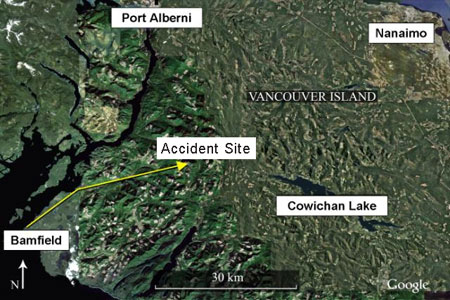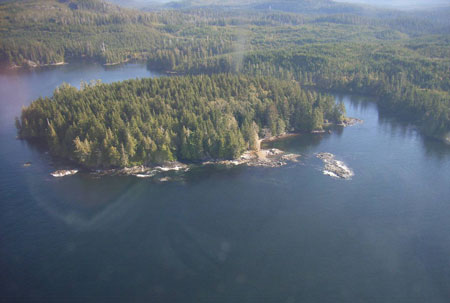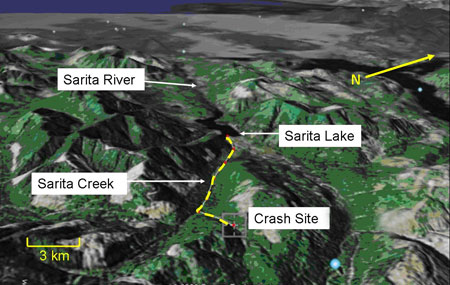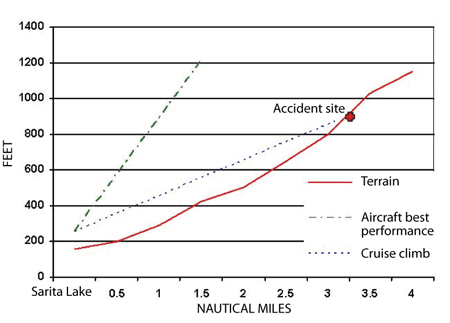Loss of Control - Collision with Terrain
Parallel Seaplanes Inc.
Cessna 172M C-GGVK
Bamfield, British Columbia, 15 nm NE
The Transportation Safety Board of Canada (TSB) investigated this occurrence for the purpose of advancing transportation safety. It is not the function of the Board to assign fault or determine civil or criminal liability. This report is not created for use in the context of legal, disciplinary or other proceedings. See Ownership and use of content. Masculine pronouns and position titles may be used to signify all genders to comply with the Canadian Transportation Accident Investigation and Safety Board Act (S.C. 1989, c. 3).
Summary
The Cessna 172M floatplane (registration C-GGVK, serial number 17266204), operated by Parallel Seaplanes Inc., was on a visual flight rules flight from Bamfield, British Columbia, to Lake Cowichan, British Columbia, with two pilots and one passenger on board. The aircraft took off from the water aerodrome at Bamfield, completed a climbing turn to the right, and proceeded north along the Trevor Channel at the south end of the Alberni Inlet. An emergency locator transmitter signal was later received from an aircraft in the area and the operator reported the aircraft overdue at about 1550 Pacific daylight time. A search and rescue effort was commenced and the wreckage was located approximately 15 nautical miles northeast of Bamfield. The accident occurred at about 1500 Pacific daylight time. The three occupants suffered fatal injuries. There was no fire.
Factual information
At approximately 1025 Footnote 1 on the morning of the accident, the floatplane had taken off on a cross-country flight from the company's main base at Lake Cowichan, British Columbia , with three persons on board. The first leg of the flight was south to Sooke, British Columbia, around the southern shore of Vancouver Island, with a stop for lunch at Bamfield. The second leg of the flight was planned to follow Nitnat Lake to return to Lake Cowichan (see Figure 1). At the completion of the first leg of the flight, the floatplane docked at the Bamfield water aerodrome at about 1200. Following lunch, the three occupants of the aircraft returned to the dock and boarded the aircraft. The pilot flying sat in the left front seat, the pilot non flying was in the right front seat, and the passenger was in the right rear seat. The aircraft left the dock at about 1430 and took off northwest bound. Rather than following the planned return route, the aircraft turned right toward the Alberni Inlet. A photograph recovered from a digital camera found in the aircraft wreckage shows Nixon Island as the aircraft flies toward the Sarita River mouth (see Photo 1). Based on that photograph, it is estimated that the aircraft was in level cruising flight at about 500 feet above the water.
From that point on, the route is not known. However, based on the location of the crash site and the known destination, it is likely that the aircraft turned inland and followed the Sarita River towards Sarita Lake (see Figure 2). The lake is large enough to land a floatplane.
The accident site was at the bottom of a small valley about 3 nautical miles (nm) from Sarita Lake. There were very few trees damaged at the site. The trees very close to the accident site, almost straight above and adjacent to the wreckage, had some damage. The area was examined from a helicopter and no other trees showed damage consistent with an aircraft strike.
The valley bottom rises gradually between Sarita Lake and the accident site. The accident site is in a smaller valley branching off the Sarita Creek valley, approximately 670 feet above Sarita Lake. This valley rises about 150 feet from the Sarita Creek valley to the accident site (0.5 nm) and a further 300 feet in 0.5 nm beyond the site. The peak elevation of this valley is about 0.75 nm past the accident site. Beyond this point the terrain drops into another valley. There is an elevation increase of 1100 feet in the 4 nm between Sarita Lake and the high point in the valley.
Wreckage Examination
The damage was consistent with impact in a steep nose-down, left bank attitude. The propeller and some of the engine's rotating components showed evidence of high power at impact. Most of the flight and engine instrument faces were broken and the indicator pointers left marks on several of the instrument faces. The airspeed indicator had a pointer mark at 40 knots and engine speed had a pointer mark at 2650 rpm. Both flight control columns were broken off and impact damage indicated full right aileron input at impact. All the flight control cables were connected and all of the control surfaces were functional. The flaps were in the up position and impact marks indicate that they were up at the time of impact.
Weather
The conditions at the time of the accident were suitable for visual flight operations. The wind was calm, visibility more than 20 nm, and there was no cloud ceiling. These conditions were observed on a photograph taken from the accident aircraft minutes before the accident.
Pilot Flying
The pilot flying in the left seat was a foreign pilot. He gained flying experience in the German Air Force and as an airline pilot (Boeing 747 captain) with Lufthansa Airlines. He held a Canadian commercial pilot license endorsed for seaplane operations. He also owned and operated a seaplane company in Europe. He was in British Columbia to add to his floatplane flying experience.
Before the accident flight, the pilot flying had a check-out flight with Parallel Seaplane's chief instructor and gained his confidence as a competent and fastidious pilot. He wanted to rent the aircraft to pick-up a friend at the Vancouver International Airport and fly in the southern Vancouver Island area. The chief instructor/company owner assigned one of his pilots to accompany him.
Pilot Non flying
The pilot non flying held a commercial pilot licence endorsed for seaplanes, had flown in the area, and had mountain flying training. On the accident flight he was acting as the designated pilot-in-command. He had received training in spin entry, spins, and spin-recovery techniques, and demonstrated instructional competency in those manoeuvres. The pilot non flying had about 635 hours of total flying time.
Aircraft Airworthiness
Examination of the technical records indicated that the aircraft was maintained within the regulations and standards governing its operation, and there were no outstanding maintenance requirements.
Weight and Balance
The maximum gross weight for the aircraft was limited to 2220 pounds due to the float configuration. It was loaded to about 2200 pounds and the centre of gravity (CG) was within limits.
Aircraft Configuration
This Cessna 172M (C-172M) had dual controls, was equipped with EDO 2000 floats, a Lycoming O-320-E2D engine (converted to 160 horsepower), and a McCauley 1A175/ETM 8042 propeller. The aircraft had been modified with the installation of a Bush conversion which incorporated two kits, Supplemental Type Certificate (STC) SA150NW and STC SA2852SW. These kits are often referred to as short take-off and landing (STOL) kits. The engine conversion was in accordance with STC 3692W.
Aircraft Performance
While the accident aircraft was equipped with a bush conversion, there were no flight manual supplements to indicate different performance information than the standard-equipped C172M on floats. Kit suppliers suggest that their conversions provide better performance, but that operators should use the standard performance charts.
The C-172M pilot's operating handbook (POH) supplement for floatplanes indicates that, at gross weight, the aircraft's best rate of climb should be 715 feet per minute (fpm). This assumes maximum power and airspeed at 64 knots. By flying the aircraft either faster or slower than this particular speed, the maximum climb rates will not be achieved.
| 3°C, no wind, 1000 feet above sea level (asl) | Feet per nm | Climb rate |
|---|---|---|
| Best rate of climb (64 knots) | 650'↑ | 700 feet per minute (fpm) |
| Cruise climb (78 knots) | 132'↑ | 150 fpm |
Illusions in Flight
In some situations, pilots can be subjected to visual illusions when approaching rising terrain. As an aircraft approaches rising terrain, pilots tend to maintain a constant visual angle between the extended cowl of the aircraft and the crest of the terrain ahead. This tendency can result in a gradual increase in aircraft pitch attitude and a concurrent decrease in the aircraft's airspeed as the aircraft approaches the elevated terrain (see Figure 3). This often results in a delay to the pilot's realization of inadequate aircraft climb performance ("a" in Figure 3), the aircraft's separation with the terrain decreases and the aircraft gets closer to aerodynamic stall as the angle of attack increases.
Aerodynamic Stall and Spin
An aerodynamic stall is a sudden reduction in the lift forces generated by an airfoil. This will occur when the critical angle of attack for the airfoil is exceeded.
A spin is a condition where an aircraft rotates around its roll axis after entering a stall, usually in a steep nose-down attitude.
Stall Speeds
Like most aircraft in its category, the C-172M is not equipped with an angle of attack indicator and speeds are used as a reference for stall. The C-172M POH shows that, at the most rearward CG, with flap selected up, the wings-level stall speed of the aircraft would be 42 knots indicated airspeed (KIAS). This speed is based on the engine at idle power and the aircraft at 2300 pounds gross weight. At bank angles of 30, 45, and 60 degrees, the stall speeds in a level turn would be about 45, 50, and 59 KIAS respectively.
Stall Warning System
The accident aircraft was equipped with a reed-type stall warning system. When the angle of attack reaches a preset value, reduced air pressure activates an aural alert to the pilot. The stall warning system is adjusted to activate between 4 and 8 knots above the stall. The effect of the bush STOL kit on the stall warning, if any, is not documented. However, anecdotal information suggested that there was little warning of a stall during a climbing turn. The aircraft was not equipped with a linear stall warning device such as an angle of attack indicator.
Stall Characteristics
When an aircraft stalls at high power, the stall speed will be slightly lower than for a power-off stall and there is an increased risk of entering a spin. STOL kits delay the onset of a stall, but the stall can then be more abrupt. During a level or climbing turn, a pilot has to apply back pressure to the control column to maintain the desired flight profile. This results in an increase in the g-forces on the aircraft which can cause the wing to stall at higher-than-normal airspeeds. Such stalls are also usually more severe.
Stall and Spin Recovery
Generally, relaxing the back pressure on the controls will allow aircraft like the Cessna 172 to recover from a stall, but to recover with a loss of less than 200 feet altitude, positive and immediate lowering of the nose is required.
Most light aircraft have to be held in a spin so relaxing the controls will eventually allow the recovery from a spin; however, much more altitude will be lost. Like a stall, positive and immediate action is required for a quick recovery. One can expect to lose about 400 feet per rotation in a spin. Full opposite rudder will stop the spin. Opposite aileron is not effective.
Transport Canada Study and Mountain Flying Training.
A 1999 Transport Canada's study of stall/spin accidents Footnote 2 found that in all but one of the 39 stall/spin accidents examined, the stalls occurred at altitudes so low that once the stall developed, recovery was not possible before impact with terrain.
Canada has no regulatory standards for mountain flying training. Pilots, including those who have had mountain flying training, have accidents in mountainous areas, often when they wait too long before deciding to turn around in a rising valley. TSB investigation report A06P0087 contains findings related to this issue.
Analysis
The wreckage examination revealed no evidence of mechanical control problems. All control surfaces were attached and the physical damage signatures indicated that the aircraft's engine was operating with high power at impact. The weather was not a factor for the proposed flight, so this analysis focuses on the operation of the aircraft and human performance.
The attitude of the aircraft at impact is consistent with a stall and spin entry. Because the speed had not increased beyond stall (the slap mark made by the airspeed indicator's pointer at impact was at 40 knots) and there was no damage to the trees around the aircraft at the accident site, it is concluded that the aircraft stalled close to the tree tops. That height was not sufficient to recover from stall before impact with terrain. Also, because the aircraft was found pointed downhill and opposite to the expected route of flight, it is likely that the stall occurred when the pilot was reversing course while flying up the valley at low level. The pilot or pilots were applying a right roll aileron control, normally the action to recover from a left roll, but not effective during a stall or spin recovery. In the stall, control was lost.
It could not be determined why the aircraft was so close to terrain in the area of the accident. It is possible they were flying low to look at something on the ground. It is also possible they had made a practice landing and take-off at Sarita Lake, but they should have been able to climb above terrain on their presumed route, unless optical illusions delayed their realization of the rising terrain and they were operating in a cruise configuration until the last moments of the flight.
When an aircraft stalls close to the ground and recovery is not affected, it impacts the terrain at close to right angles, thereby exposing the aircraft and its occupants to high deceleration forces. If control is maintained, that is to say the wings are not stalled and the aircraft is flown into gradually rising terrain, the deceleration forces are likely to be spread over a longer time and are more survivable. Because most general aviation aircraft are not equipped with linear stall warning devices such as angle of attack indicators, pilots may not always be aware of how close to stalling the aircraft they are.
In this accident, the horn would not likely have sounded early enough to give either pilot time to take action to avoid the stall.
The pilot non flying was trained in mountain flying techniques, but for unknown reasons, the aircraft was being flown close to terrain. It is possible that both pilots were lulled into a false sense of security due to visual illusions and the lack of a linear stall warning device. Also, the experience level of the pilot flying may have caused the pilot-in-command to be less vigilant.
The following TSB laboratory report was completed:
- LP 111/2007 – Noise Attenuating Headset Effect on Stall Warning
This report is available from the Transportation Safety Board of Canada upon request.
Finding as to Causes and Contributing Factors
- The aircraft was operating close to terrain and was reversing course when it stalled and started a spin at an altitude from which there was insufficient height to recover before it collided with terrain.
Findings as to Risk
- Pilots are not always aware of how close to a stall they are, as few general aviation aircraft are equipped with linear stall warning devices, such as angle of attack indicators.
- There are no regulatory standards for mountain flying training in Canada and pilots continue to delay their decisions to turn around until it is too late to safely do so.
This report concludes the Transportation Safety Board's investigation into this occurrence. Consequently, the Board authorized the release of this report on .




